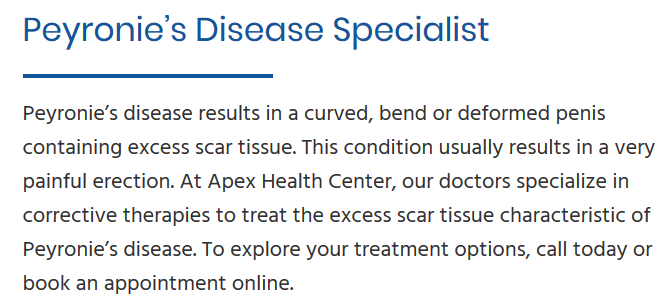Peyronie’s Disease statistics
- Peyronie’s disease may affect 1% to 10% of men; estimates vary because the disease is under-reported by affected men
- Peyronie’s disease affects 8 to 10% of men under the age of 40
- Progression of Peyronie’s disease stops 3 to 12 months after onset
- One-third of affected men have abnormal scar tissue in other anatomical locations
- The majority of affected men experience sexual dysfunction
- 75% of affected men suffer from depression and stress
- Xiaflex injections can improve symptoms of Peyronie’s disease by 33% to 35%
Peyronie’s disease is very common
Peyronie’s disease is characterized by a severely curved penis. While most men have a minor degree of penile curvature when erect, men with Peyronie’s disease can have curvatures of 30 degrees or even higher, with some men developing 90 degrees or even sharper curves. An estimated 1% of men have been formally diagnosed with Peyronie’s disease, but due to lack of awareness of the disease and the reluctance of men to seek medical care, some researchers estimate it may affect as many as one in ten men, primarily men between the ages of 40 and 70.
Peyronie’s disease occurs in young men, too
Although it usually affects middle-aged and older men, Peyronie’s disease can occur in men as young as age 20. Around 8% to 10% of affected men are under the age of 40.
Peyronie’s disease stabilizes
The initial trigger for most cases of Peyronie’s disease is thought to be some sort of trauma to the penis that occurs during a sporting activity, a fall, or sex, or rather than one single traumatic event, it might be triggered by repeated episodes of micro-traumas. After this condition is triggered to develop, during the acute phase, a lump of scar tissue builds up in the penis, causing the penis to curve sharply to one side, downward, or upwards during an erection. Sometimes, it develops a narrow band of scar tissue around one area, giving the erect penis an hourglass-like shape. Peyronie’s disease progresses either slowly or quickly after onset, but it usually stabilizes three to 12 months after onset and the changes of the penis shape don’t get any worse. However, the condition may continue to be quite painful for up to 24 months, after which the pain tends to improve, although the curvature does not.
Affected men are likely to have scar tissue elsewhere
Although Peyronie’s disease is thought to be primarily triggered by trauma or damage to the penis, not everyone who experiences trauma to the penis goes on to develop the condition. There seems to be an underlying predisposition; for example, it tends to run in families. In addition, around one-third of affected men also have abnormal scar tissue in other parts of their body, such as on the palms of their hands or the soles of their feet.
Sexual dysfunction
While Peyronie’s disease does not cause physical morbidity or mortality, the majority of men with the condition are unable to have sexual intercourse due to the abnormally-shaped penis being unable to be inserted. In addition, many men with the condition have erectile dysfunction. Drugs like Viagra can help with the erectile dysfunction but not the abnormal shape of the penis.
Peyronie’s disease causes stress and depression
Most men with Peyronie’s disease suffer a serious impairment of quality of life. An estimated 75 out of 100 men with the condition are seriously stressed and depressed about it. However, rather than seek medical help, men generally choose to suffer in silence either because they are embarrassed by the condition or don’t realize it isn’t normal and does have treatment options.
Treatment
The only FDA-approved treatment for Peyronie’s disease is a series of injections of Xiaflex into the scar tissue that is causing the penile curvature. This drug enzymatically breaks down the scar tissue. It was studied in a placebo-controlled trial. The men each received four injections of Xiaflex or placebo, and men in both groups also engaged in daily gentle stretching of their penis. At the end of trial, the men in the Xiaflex group had a 33% to 35% improvement versus 18% to 22% in the placebo group.
Xiaflex is reasonably safe, but it sometimes causes hematomas to form at the injection site that may need to be drained with a needle. In rare cases, it has severely damaged the tissues of the penis, causing penile ruptures and erectile dysfunction.
Other treatments for the condition include various surgical procedures. The scar tissue can be cut in several locations, allowing the penis to straighten out. Alternatively, one side of the penis can be slightly shortened, again allowing it to straighten out. The shortening procedure is less likely to cause erectile dysfunction than the scar-cutting process. Another alternative is to place an implant to help straighten the penis. If an implant is placed, it will be necessary to use a pump to achieve an erection.
